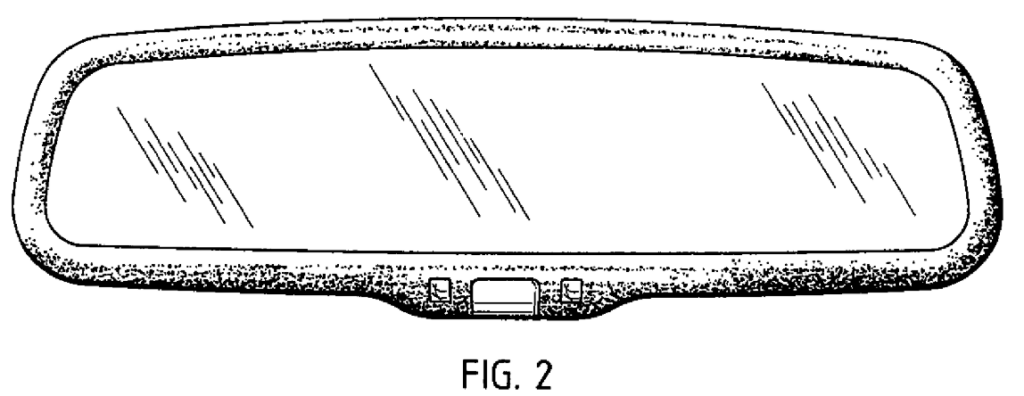Opening arguments in Apple v. Samsung started this morning. While round six of the long-running case deals with smartphone patents, the potential impacts range much further. As I noted in my post yesterday, a rule of design patentAs distinct from a utility patent. A design patent protects only the ornamental design or appearance of an article of manufacture, but not its structural or functional features. An ‘article of manufacture’ is a broad term which may extend even to computer icons. Like utility patents, design patents must be nonobvious but this standard is harder to apply to designs. damages that allows patentees to receive the total profits on the entire product even though the design is only applied to a small component of that product could have potentially negative impacts almost everywhere.
Let’s start with one area that impacts nearly everyone—the auto industry.
Parts Of A Much Larger Whole
Before becoming a lawyer, I worked for a Tier 1 supplier as an automotive engineer. Tier 1 suppliers primarily sell integrated components directly to auto manufacturers like Ford or Daimler, and their products typically include components from smaller suppliers (so-called Tier 2 and Tier 3 suppliers).
A typical car might include more than 15,000 parts, made by more than 20 different Tier 1 suppliers, which each source components from dozens of Tier 2 and Tier 3 suppliers. Even your cup holder might be composed of multiple molded plastic pieces and some metal to attach it to the vehicle structure. Most of those components have little to nothing, individually, to do with the decision to buy the car. A cup holder, however pretty, just isn’t worth buying a car for.
But each and every one of those thousands of components ultimately winds up in a vehicle selling for tens of thousands of dollars.
Looking Ahead Via Rear View Mirrors
Let’s take your rear view mirror. It probably looks a little bit like this:

That image is taken from D556,105, assigned to Gentex (a Tier 1 supplier). The D’105 patent was granted in 2007, which means it will expire in 2021, 14 years after grant.[1. Unlike utilityAn invention must useful to be patentable. Very few inventions are invalidated as lacking utility. Perpetual motion machines, for example, are typically found invalid for lacking utility. patents, whose term starts at filing, the term of a design patentAs distinct from a utility patent. A design patent protects only the ornamental design or appearance of an article of manufacture, but not its structural or functional features. An ‘article of manufacture’ is a broad term which may extend even to computer icons. Like utility patents, design patents must be nonobvious but this standard is harder to apply to designs. only begins to run once it’s been granted.]
In a world where a single infringing component can result in total profits on the entire product, if a Ford vehicle used a rear view mirror that infringed Gentex’s rear view mirror patent, Ford could end up owing Gentex the entire profit on the whole vehicle. And it doesn’t matter if Ford knew the mirror infringed; it’s enough that Ford sold it as part of their product.
Now, the four factor test Judge Koh selected in Apple v. Samsung might or might not allow a jury to treat the entire vehicle as the “article of manufacture” to which a design for a rear view mirror was applied. But then again, it might—one of the flaws of Judge Koh’s test is that it’s hard to predict, ex ante, how it will be applied.
But rear view mirrors aren’t the only part of a car where design patents exist.
Windshields Won’t Protect You From Design PatentAs distinct from a utility patent. A design patent protects only the ornamental design or appearance of an article of manufacture, but not its structural or functional features. An ‘article of manufacture’ is a broad term which may extend even to computer icons. Like utility patents, design patents must be nonobvious but this standard is harder to apply to designs. Infringement
Let’s take the windshield. This isn’t a straw man—just last week, Patent Progress covered a design patentAs distinct from a utility patent. A design patent protects only the ornamental design or appearance of an article of manufacture, but not its structural or functional features. An ‘article of manufacture’ is a broad term which may extend even to computer icons. Like utility patents, design patents must be nonobvious but this standard is harder to apply to designs. lawsuit by Nikola against Tesla where one of the asserted patents was a windshield design patentAs distinct from a utility patent. A design patent protects only the ornamental design or appearance of an article of manufacture, but not its structural or functional features. An ‘article of manufacture’ is a broad term which may extend even to computer icons. Like utility patents, design patents must be nonobvious but this standard is harder to apply to designs..
Using Judge Koh’s four factors, there’s a real possibility that a jury could decide that the article of manufacture for a windshield design patentAs distinct from a utility patent. A design patent protects only the ornamental design or appearance of an article of manufacture, but not its structural or functional features. An ‘article of manufacture’ is a broad term which may extend even to computer icons. Like utility patents, design patents must be nonobvious but this standard is harder to apply to designs. was the entire car and thus award total profits on the vehicle.
The first factor is the scope of the design claimed in the plaintiff’s patent. A design patentAs distinct from a utility patent. A design patent protects only the ornamental design or appearance of an article of manufacture, but not its structural or functional features. An ‘article of manufacture’ is a broad term which may extend even to computer icons. Like utility patents, design patents must be nonobvious but this standard is harder to apply to designs., like Nikola’s, which shows the windshield in the context of the entire vehicle (even though the vehicle is in broken lines and thus not claimed) might well be interpreted by a jury to have a scope incorporating the entire vehicle.
The second factor is the relative prominence of the design within the product. While a windshield isn’t the entirety of the vehicle, it’s a prominent portion of the way the vehicle looks—the shape and angle of the windshield impact the profile of the car, and while you might not buy a car just for the cup holder, you might buy it based at least in part on looks.
The third factor is conceptual distinctness. Is a windshield conceptually distinct from the car? It is, in the same way the housing of a phone is distinct from the phone, but both are also integrated into the product as a whole.
Finally, there’s the physical relationship between the design and the product. The windshield, like the phone housing, is part and parcel of the product. Each can be individually replaced, but generally speaking, in both cases customers can’t buy a new replacement part directly. Instead, they have to go through the manufacturer or their authorized dealers.
While the flawed test being applied can be twisted to fit either view, the reasonable result has to be that the article of manufacture is the component, not the entire product. The windshield (or phone housing), not the vehicle (or phone).
But if the jury reaches the result that the entire product is the article of manufacture, what’s the impact in the automotive context?
Impacts Are Huge And Disproportionately Affect SMEs
The entire profits on a vehicle is a lot of money at risk. Now, a mid-tier Tier 1 supplier might have $5-7 billion in yearly global sales. A Tier 1 supplier might be big enough to indemnify Ford against the risk of a total profits award. But even a Tier 1 supplier might think twice at doing so.
Let’s assume this infringing mirror was put into the Ford F-150. Ford sold 820,000 F-150s in 2016, at an estimated profit per F-150 of $13,000. That’s a potential $10.7 billion damages award.[2. If that sounds bad, consider the possibility of a design patentAs distinct from a utility patent. A design patent protects only the ornamental design or appearance of an article of manufacture, but not its structural or functional features. An ‘article of manufacture’ is a broad term which may extend even to computer icons. Like utility patents, design patents must be nonobvious but this standard is harder to apply to designs. verdict on an airliner cockpit arrangement being applied to the profit on the entire airplane.] Even the largest Tier 1 suppliers, companies like Denso ($40.2 billion in yearly sales) or Continental (around $48 billion), might balk at signing up for that kind of indemnity.
And that’s the largest suppliers. Tier 2 and 3 suppliers are often small and medium-sized enterprises (SMEs). And, in a world where even the largest companies simply can’t perform freedom-to-operate analyses on their products, SMEs are simply unable to mitigate the kind of risk that design patentAs distinct from a utility patent. A design patent protects only the ornamental design or appearance of an article of manufacture, but not its structural or functional features. An ‘article of manufacture’ is a broad term which may extend even to computer icons. Like utility patents, design patents must be nonobvious but this standard is harder to apply to designs. infringement poses when applied to an entire vehicle. Given that inability, the automakers and Tier 1 suppliers have to reconsider how much risk they’re willing to tolerate. When there’s $10 billion at risk, companies are going to be a lot less likely to give that opportunity to smaller businesses and businesses with new innovative ideas.
A design patentAs distinct from a utility patent. A design patent protects only the ornamental design or appearance of an article of manufacture, but not its structural or functional features. An ‘article of manufacture’ is a broad term which may extend even to computer icons. Like utility patents, design patents must be nonobvious but this standard is harder to apply to designs. rule that puts the entire profits on a car at risk is one that creates a vehicle market less willing to take risks on new designs and thereby hurts small and medium-sized businesses.

